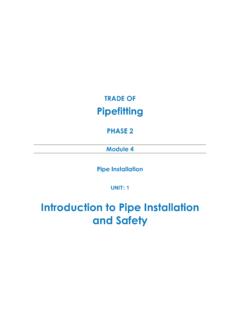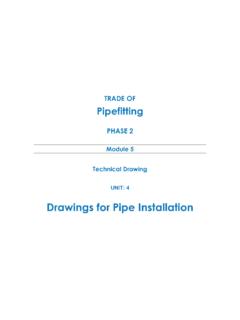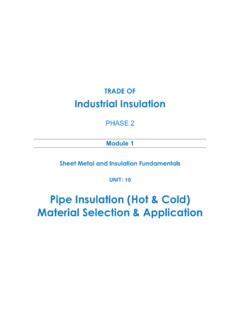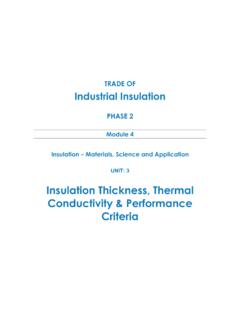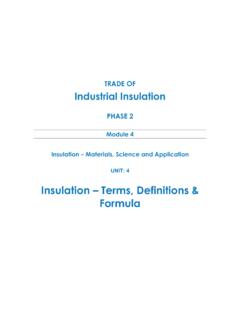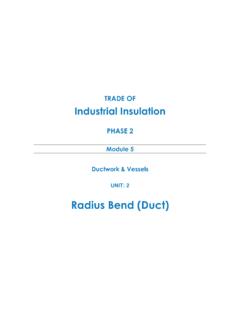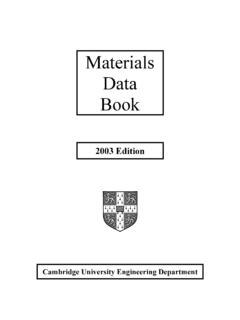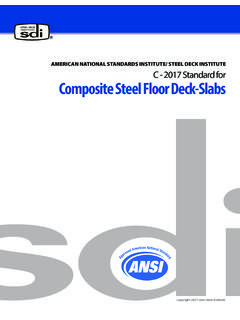Transcription of Measuring, Marking & Cutting Out - eCollege
1 TRADE OF Industrial Insulation PHASE 2 Module 1 Sheet Metal and Insulation Fundamentals UNIT: 3 measuring , Marking & Cutting Out Produced by In cooperation with subject matter expert: Michael Kelly SOLAS 2014 Module 1 Unit 3 Industrial Insulation Phase 2 1 measuring , Marking & Cutting Out Revision , August 2014 Table of Contents Unit Objective .. 2 Introduction .. 3 Hand Tools .. 4 Marking Out Tools .. 4 Hammers and Mallets .. 11 Cutting Tools .. 13 Files .. 16 Pop Riveting Guns .. 16 Workshop 18 Safety in the Workshop .. 18 The Box and Pan Folding Machine .. 19 The Guillotine .. 20 The Bending Rolls .. 21 Lubricating Machines .. 21 Measurements .. 22 SI Units of Measurement .. 22 The Imperial System .. 23 The Metric System .. 23 Angle and Straight Line Bisection .. 23 Metals.
2 24 Sheet Steels .. 24 Coated and Solid Sheets .. 24 Galvanised Sheet Metal .. 25 Stainless Steel .. 25 Non-Ferrous Sheet Metals .. 26 Properties of Metal .. 27 Cutting a Sheet Metal Blank .. 29 Job Planning & Preparation .. 29 Drawing Symbols and Orthographic Projections .. 29 Marking Out .. 30 Cutting .. 30 De-Burring .. 30 Checking Measurements .. 30 Vernier Callipers .. 30 Summary .. 32 Module 1 Unit 3 Industrial Insulation Phase 2 2 measuring , Marking & Cutting Out Revision , August 2014 Unit Objective By the end of this unit each apprentice will be able to: Identify and name a selection of machinery. State the use of each tool and machine. Identify the hazards associated with each piece of equipment. Mark out and cut a sheet metal blank. De-burr a sheet metal blank Check measurements using a steel rule.
3 Module 1 Sheet Metal & Insulation Fundamentals Unit 1 Introduction to the Workshop Environment Unit 2 Manual Handling Unit 3 measuring , Marking & Cutting Out Unit 5 General Allowances for Insulation & CladdingUnit 4 Notching, Folding & Joining Unit 6 Marking , Cutting , Punching, Rolling, Seam Swagingn & Screwing Unit 7 Swaging (Basic) Male/Female & Flange Turning Unit 8 Pipe Cladding (Basic) Fabrication & Application Unit 9 Metal Cladding Assembly Work Unit 10 Pipe Insulation (Hot & Cold) Material Selection & Application Unit 11 Valve & Flange Box FundamentalsModule 1 Unit 3 Industrial Insulation Phase 2 3 measuring , Marking & Cutting Out Revision , August 2014 Introduction One of the characteristics of the skilled worker is the way in which he selects and uses his tools. For this reason, it is essential that you know how to select and use both hand and machine tools correctly.
4 If you do this you will save time and the work will be much easier. When you have selected the correct tool for the correct operation you have taken the first step in becoming a successful craftsman. Module 1 Unit 3 Industrial Insulation Phase 2 4 measuring , Marking & Cutting Out Revision , August 2014 Hand Tools Sheet metal hand tools are used to scribe or measure lines, perform layout operations and shape or cut metals. Some of the hand tools in the following notes actually perform these operations while others, such as stakes and punches, serve as aids in performing them. It is important to keep tools in good shape. Avoid tools going rusty by giving steel tools an occasional oiling. Tools with a sharp point should be stored carefully. Marking Out Tools Scriber This is used to mark lines on metal.
5 It can be used in conjunction with a straight edge and square. Key Learning Points Location and identification of tools, equipment and machinery. Description of the application of the tools, equipment and machinery. Interpretation of tool, machinery and equipment manuals. Module 1 Unit 3 Industrial Insulation Phase 2 5 measuring , Marking & Cutting Out Revision , August 2014 Straight Edge The Straight Edge is used as a guide for a scriber or pencil when Marking or drawing a straight between two points. It is also used in conjunction with square to draw lines at right angles. Dividers This is made with each straight leg tapered to a needle point. Dividers are manufactured in various sizes and types and are used to space off equal distances, to divide lines into equal parts and to scribe arcs and circles.
6 Spring loaded screw dividers are also available. Supplied in lengths from 150mm to 500mm. Spring dividers are also available in sizes from 75mm to 300mm. Module 1 Unit 3 Industrial Insulation Phase 2 6 measuring , Marking & Cutting Out Revision , August 2014 Steel Square The flat Steel Square is used to layout right angles (90 ) and can also be used as a scale. It is an invaluable tool for accurate layout work in pattern drafting. The long arm is known as the body or blade, the short arm is known as the heel or tongue. These squares come in various sizes. Steel Try Square It is used for Marking and checking right angles (90 ). These squares come in various sizes from 75mm to 300mm. Module 1 Unit 3 Industrial Insulation Phase 2 7 measuring , Marking & Cutting Out Revision , August 2014 Combination Square This is one of the most useful and convenient tools for laying out small work.
7 It is used as a square for measuring or laying out 90 or 45 angles. A spirit level is mounted in the stock. Available in 300mm lengths. Protractor This is a device for measuring and laying out angles from the edge of the work. This protractor consists of a head and a movable blade. The head of the protractor has a semicircular scale graduated from zero to 180 . Module 1 Unit 3 Industrial Insulation Phase 2 8 measuring , Marking & Cutting Out Revision , August 2014 Trammel Points These are used for scribing large arcs and circles. They are manufactured in various types with two straight, removable legs tapered to needle points and attached to separated heads or holders. The heads or holders slide on wood or steel beams and are held in place by thumb screws. Either of the points can be removed and often one point has adjustment for fine settings.
8 A special clamp for a pencil can be attached to one of the points. Steel Rule Steel rules are manufactured in a variety of types and lengths; each of which is designed for measuring or laying out different work. Available in lengths from 100mm to 1000mm. Module 1 Unit 3 Industrial Insulation Phase 2 9 measuring , Marking & Cutting Out Revision , August 2014 Centre Punch Similar in design to the prick punch except that the tapered point is ground to an angle of 90 included. They are available in various shapes and sizes and are used for locating centres for drilling etc. Prick Punches Prick Punches are made of tool steel and having a tapered point ground to approximately 30 included angle. These punches are used for making small dents or indentations and/or establishing points for dividers and trammel points.
9 Module 1 Unit 3 Industrial Insulation Phase 2 10 measuring , Marking & Cutting Out Revision , August 2014 Steel Circumference Rule This is used much like the common rule. It is invaluable for laying out patterns. It is available in metric or imperial graduations. Its length is 24 or 600mm depending on the type. The purpose of this rule is for finding the circumference of cylinders and for angular measurement. Tape Rule It is very popular for measuring and laying out large jobs. Available in various lengths, Module 1 Unit 3 Industrial Insulation Phase 2 11 measuring , Marking & Cutting Out Revision , August 2014 Hammers and Mallets Stretching Hammer This is used for stretching edges and flanges on curved work. It is normally used in conjunction with a stake. Planishing Hammer The principal purpose of the Planishing Hammer is for smoothing and finalising a surface after it has been roughed out to the required shape.
10 Module 1 Unit 3 Industrial Insulation Phase 2 12 measuring , Marking & Cutting Out Revision , August 2014 Cross Pein Hammer This is used by the Industrial insulator for general use in the metal shop and on site. Engineers Ball Pein This is used for striking chisels, punches, rivets etc. And for general engineering use. Module 1 Unit 3 Industrial Insulation Phase 2 13 measuring , Marking & Cutting Out Revision , August 2014 Boxwood and Rubber Mallets These mallets can be used on mild steel, copper or aluminium to prevent marring the metal. Cutting Tools Straight Snips These snips are used for straight line Cutting . They are available in many different sizes. Available from 200mm to 350mm long. Module 1 Unit 3 Industrial Insulation Phase 2 14 measuring , Marking & Cutting Out Revision , August 2014 Combination Snips These snips are used to cut straight and irregular lines and curves.
